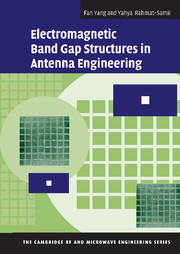Book contents
- Frontmatter
- Contents
- Preface
- Acknowledgements
- Abbreviations
- 1 Introduction
- 2 FDTD method for periodic structure analysis
- 3 EBG characterizations and classifications
- 4 Designs and optimizations of EBG structures
- 5 Patch antennas with EBG structures
- 6 Low profile wire antennas on EBG ground plane
- 7 Surface wave antennas
- Appendix: EBG literature review
- Index
- References
2 - FDTD method for periodic structure analysis
Published online by Cambridge University Press: 06 July 2010
- Frontmatter
- Contents
- Preface
- Acknowledgements
- Abbreviations
- 1 Introduction
- 2 FDTD method for periodic structure analysis
- 3 EBG characterizations and classifications
- 4 Designs and optimizations of EBG structures
- 5 Patch antennas with EBG structures
- 6 Low profile wire antennas on EBG ground plane
- 7 Surface wave antennas
- Appendix: EBG literature review
- Index
- References
Summary
FDTD fundamentals
Introduction
A fundamental quest in electromagnetics and antenna engineering is to solve Maxwell's equations under various specific boundary conditions. In the last several decades, computational electromagnetics has progressed rapidly because of the increased popularity and enhanced capability of computers. Various numerical techniques have been proposed to solve Maxwell's equations [1]. Some of them deal with the integral form of Maxwell's equations while others handle the differential form. In addition, Maxwell's equations can be solved either in the frequency domain or time domain depending on the nature of applications. The success in computational electromagnetics has propelled modern antenna engineering developments.
Among various numerical techniques, the finite difference time domain (FDTD) method has demonstrated desirable and unique features for analysis of electromagnetic structures [2]. It simply discretizes Maxwell's equations in the time and space domains, and electromagnetics behavior is obtained through a time evolving process. A significant advantage of the FDTD method is the versatility to solve a wide range of microwave and antenna problems. It is flexible enough to model various media, such as conductors, dielectrics, lumped elements, active devices, and dispersive materials. Another advantage of the FDTD method is the capability to provide a broad band characterization in one single simulation. Since this method is carried out in the time domain, a wide frequency band response can be obtained through the Fourier transformation of the transient data.
Because of these advantages, the FDTD method has been widely used in many electromagnetic applications.
Information
- Type
- Chapter
- Information
- Publisher: Cambridge University PressPrint publication year: 2008
References
Accessibility standard: Unknown
Why this information is here
This section outlines the accessibility features of this content - including support for screen readers, full keyboard navigation and high-contrast display options. This may not be relevant for you.Accessibility Information
- 4
- Cited by
